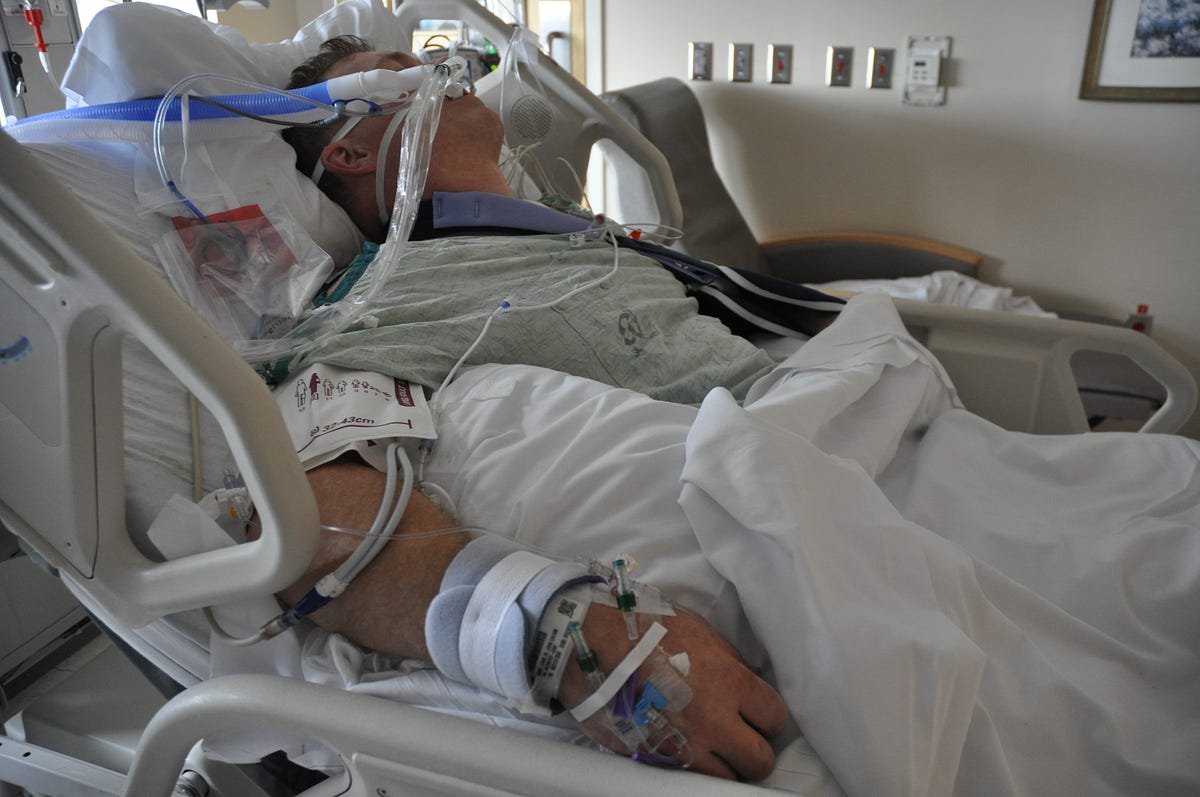If you or a loved one ever face the need for a ventilator, you probably have many questions. One of the biggest concerns is often: how long can someone be on a ventilator?
Understanding this can help ease your worries and prepare you for what to expect. You’ll discover the key factors that affect ventilator use, what the typical timeframes look like, and how medical teams decide when to wean someone off. Keep reading to get clear, straightforward answers that can guide you through this challenging time.
Ventilator Basics
Understanding the basics of ventilators is essential, especially if you or a loved one ever faces the need for breathing support. Ventilators are machines designed to assist or replace natural breathing when lungs can’t function properly. Grasping how they work and why they’re used can help you feel more informed and less anxious about this critical medical tool.
Types Of Ventilators
Ventilators come in several types, each suited for different needs and situations. The most common is the invasive ventilator, which uses a tube inserted into the windpipe to deliver air directly to the lungs.
There are also non-invasive ventilators, which use masks to help you breathe without the need for tubes. These are often used for less severe cases or during recovery.
Some ventilators are portable, helpful for patients who need support outside of a hospital, while others are more complex machines found in intensive care units. Knowing the type used can give you insight into the severity of the condition and the level of care required.
When Ventilation Is Needed
Ventilation becomes necessary when your lungs cannot provide enough oxygen to the body or remove carbon dioxide effectively. This can happen due to illnesses like pneumonia, chronic obstructive pulmonary disease (COPD), or during surgery when you are under anesthesia.
Doctors also use ventilators for patients with severe injuries or neurological problems that affect breathing. You might wonder how long someone can stay on a ventilator. The answer depends on the underlying condition and how well the patient responds to treatment.
Recognizing the signs that indicate the need for ventilation can be life-saving. Shortness of breath, low oxygen levels, and extreme fatigue are red flags your medical team watches closely.

Credit: www.goodrx.com
Duration Factors
The length of time someone stays on a ventilator depends on many factors. These factors affect how quickly a person can breathe on their own again. Understanding these can help families and caregivers prepare and support the patient during recovery.
Patient’s Health Condition
Health plays a big role in ventilator duration. A strong immune system can help patients recover faster. Patients with weak lungs or other health problems may need longer support. The body’s ability to heal affects how soon the ventilator can be removed.
Underlying Illness Impact
The cause of breathing failure matters. Some illnesses like pneumonia may need shorter ventilator use. Chronic diseases such as COPD or heart failure often require more time. The severity and type of illness guide doctors on the expected duration.
Age And Recovery
Age influences healing speed. Younger patients usually recover faster and spend less time on ventilators. Older adults may face more challenges and longer recovery. Age can also affect how well the body responds to treatment.
Short-term Ventilation
Short-term ventilation supports breathing for patients who need temporary help. It assists the lungs until they recover enough to work alone. This type of ventilation usually lasts from hours to a few days. Medical teams watch patients closely to decide the right time to stop.
Typical Time Frames
Short-term ventilation often lasts less than a week. Most patients stay on a ventilator for 24 to 72 hours. Some may need a few more days if recovery is slow. Doctors aim to reduce ventilation time to avoid complications.
Common Scenarios
- After surgery, especially major operations.
- Severe infections affecting breathing.
- Trauma or accidents causing lung injury.
- Sudden breathing failure from asthma or pneumonia.
Long-term Ventilation
Long-term ventilation refers to the use of a mechanical ventilator to support breathing for an extended period, often beyond days or weeks. This can happen in cases of chronic respiratory failure, neurological conditions, or severe injuries. Understanding what long-term ventilation means for both the patient and their caregivers is crucial to managing expectations and care plans.
Extended Use Challenges
Using a ventilator for a long time can bring several challenges. Physical complications like lung infections, muscle weakness, and airway damage are common risks. You might also face issues with ventilator settings needing frequent adjustments to match changing respiratory needs.
Another challenge is managing the psychological impact. Patients often experience anxiety, depression, or a feeling of loss of independence. Caregivers must stay alert to these signs and seek professional support when needed.
Quality Of Life Considerations
Long-term ventilation can significantly affect your daily life and routines. It may limit mobility and social interactions, making simple activities harder to enjoy. However, many patients find ways to adapt and maintain a meaningful life by focusing on what they can control.
Communication becomes key—whether through speech aids or other tools—to stay connected with loved ones. You should also think about setting realistic goals and celebrating small victories. What are the things that still bring you joy despite these limitations?
Risks And Complications
Being on a ventilator is a life-saving intervention for many, but it comes with its own set of risks and complications. Understanding these potential challenges can help you or your loved ones make informed decisions. Let’s delve into some of the most common complications associated with prolonged ventilator use.
Ventilator-associated Pneumonia
One significant risk is ventilator-associated pneumonia (VAP). When a tube is inserted into your airway, it can become a pathway for bacteria to enter your lungs. This can lead to infections, making recovery more difficult and prolonging hospital stays.
Preventing VAP requires diligent care and hygiene practices. Healthcare providers often use specialized cleaning protocols to minimize this risk. Are you aware of the steps being taken to protect patients from such infections?
Muscle Weakness
Prolonged use of a ventilator can lead to muscle weakness. When your body relies on a machine for breathing, your respiratory muscles might not get the exercise they need. This can lead to a condition known as ICU-acquired weakness.
Physical therapy and gradual weaning from the ventilator can help regain muscle strength. Have you or a loved one experienced the challenges of regaining strength after being on a ventilator?
Psychological Effects
The psychological impact of being on a ventilator is often underestimated. Patients may experience feelings of anxiety, depression, or post-traumatic stress. The inability to communicate effectively while intubated can amplify these feelings.
Support from mental health professionals and family can play a crucial role in recovery. How can you ensure emotional support is part of the care plan for those on ventilators?

Credit: medium.com
Weaning Off The Ventilator
Weaning off the ventilator is a crucial step for patients recovering from serious illness. This process involves reducing and eventually stopping the machine that helps with breathing. It requires careful monitoring and planning. The goal is to help patients breathe on their own safely and comfortably.
Assessment For Readiness
Doctors check many factors before starting weaning. They look at lung function and overall strength. Blood tests and chest X-rays help assess lung health. Patients must be able to breathe deeply and cough effectively. Stable heart rate and blood pressure are important too. The patient’s mental state is also considered to ensure cooperation.
Weaning Methods
Several methods exist to help patients breathe independently. One common approach is the spontaneous breathing trial. Here, the ventilator support is reduced, and patients try breathing with less help. Another method uses gradual reduction of ventilator settings over time. Some patients may use pressure support ventilation to assist breathing. Doctors choose the best method based on patient condition.
Possible Setbacks
Weaning is not always smooth. Patients can experience fatigue or breathing difficulty. Lung infections or fluid build-up may cause setbacks. Sometimes, the patient needs to return to full ventilator support. Emotional stress and anxiety can also affect progress. Medical teams watch closely to manage these challenges and adjust care plans.
Support For Patients And Families
Support for patients on a ventilator and their families is crucial throughout the entire experience. Being on a ventilator can be overwhelming, not only for the patient but also for loved ones who often face uncertainty and emotional strain. Providing practical tools and compassionate care helps everyone navigate this challenging time with greater confidence and connection.
Communication Tips
Clear communication can feel tough when a patient is unable to speak due to the ventilator. Simple tools like whiteboards, picture cards, or even smartphone apps designed for communication can make a big difference. Encourage family members to ask yes/no questions or use gestures to help the patient express needs and feelings.
Have you noticed how a gentle touch or eye contact can sometimes convey more than words? Paying attention to nonverbal cues can reveal a lot about how the patient is feeling. Staying patient and giving the person time to respond helps reduce frustration for everyone involved.
Emotional Support
Facing ventilation can stir up fear and loneliness for both patients and their families. Offering emotional support means listening without judgment and acknowledging fears honestly. Sometimes, just being present and holding a hand provides comfort that words cannot.
Families often feel isolated during long hospital stays. Connecting with support groups or counseling services can provide a safe space to share experiences and find strength. Remember, your emotional well-being is as important as the patient’s physical care.
Planning For Care
Preparing for life on a ventilator involves more than medical treatment; it includes planning daily care and long-term needs. Discussing care preferences early with healthcare providers helps set clear goals and expectations. This can include decisions about feeding, mobility, and how to manage complications.
Have you thought about who will help with care after leaving the hospital? Organizing home support, equipment, and training for caregivers ahead of time reduces stress later on. Being proactive lets you focus more on recovery and less on logistics.

Credit: www.agapehospicepc.org
Frequently Asked Questions
How Long Can A Patient Stay On A Ventilator?
A patient can stay on a ventilator from a few days to several weeks. Duration depends on their illness and recovery speed. Some may need long-term ventilation if lung function remains weak or complications arise.
What Factors Influence Ventilator Duration?
Ventilator duration depends on illness severity, lung health, age, and response to treatment. Complications or infections can prolong ventilation. Doctors closely monitor patients to decide when to wean them off the ventilator safely.
Can Long-term Ventilation Cause Complications?
Yes, long-term ventilation may cause lung damage, infections, or muscle weakness. Doctors balance benefits and risks while providing supportive care. Early mobilization and physical therapy help reduce complications during extended ventilation.
How Is Ventilator Weaning Determined?
Weaning depends on patient’s ability to breathe independently, oxygen levels, and overall health. Doctors gradually reduce ventilator support while monitoring vital signs. Successful weaning means the patient can maintain stable breathing without assistance.
Conclusion
Time on a ventilator varies for each patient. Many factors affect the length of use. Doctors closely watch progress and adjust care. Some recover quickly; others need longer support. The goal is always to help patients breathe on their own.
Families should stay informed and ask questions. Ventilator care requires patience and hope. Understanding the process eases worry and builds trust. Every case is unique, so treatment changes as needed. Staying positive and informed helps everyone involved.





